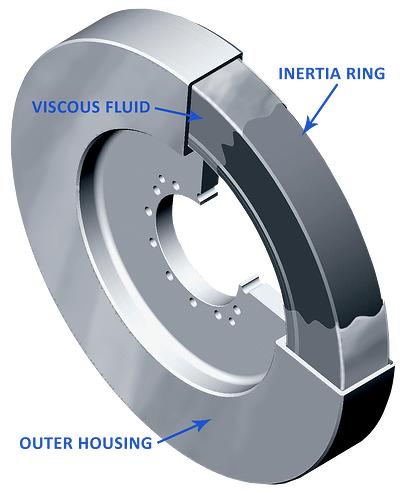In Part 1 we defined a viscous damper as a fundamental component to create durability and efficiency in a powertrain system by reducing torsional vibration.
To understand what torsional vibration is, we turn to Aaron Neyman, Vibratech TVD Snr. Product Engineer and Torsional Vibration Analyst who stated in an exclusive EngineLabs.com interview:
Torsional vibration is the speed fluctuation of a rotating shaft. [It] can have two components, twist and rigid body motion. Twist is the kind of vibration that is expected when you think of crankshaft torsional vibration. From one end of the shaft to another the vibration amplitudes change direction. When this happens there is a point where there is no vibration amplitude. This is called a nodal point. The material stresses are the highest at a nodal point. Rigid body motion is when the rotating shaft has torsional vibration but there is no nodal point along the shaft. The vibration does not change direction.

Three Main Damper Components
A general industrial and commercial standard for durability and efficiency is to maintain torsional vibration within < 0.2 degrees peak twist. To accomplish this the design is composed of three main components:
- Outer Housing
- Inner Inertia Ring
- Viscous Fluid
The outer housing is directly connected to the shaft and moves with shaft rotation. Inside the inner inertia ring freely rotates in a thin layer of viscous fluid. As a vibration event happens it causes the outer housing and inner inertia ring to rotate independently at different speeds. The resulting shear action through the viscous fluid diminishes the vibration by transforming it to heat. Chad Westfall, engineer and editor at DieselArmy.com describes shear in the article Viscous Dampers: How It Works, aka Harmonic Balancers as:
Shear itself can be described as the normal force resisting movement. In fluid mechanics, shear (τ) is equal to the viscosity (μ) multiplied by the change in velocity per distance (τ = μ*[dv/dy] ). While you don’t necessarily need to understand what this equation is, it is important to take away a few key points. First, the greater the viscosity the greater the shear force and secondly, as the change in velocity increases, so does the shear force.
Why Silicone
With over 65 years of developing viscous dampers over a wide variety of industrial and commercial applications, Vibratech TVD chooses a premium viscous silicone fluid to generate shear. Over time, silicone has proven to be an excellent damping medium because it contributes to long damper life by exhibiting:
- High energy dissipation
- High tensile strength
- Effective across a broad range of frequencies and rpms
The benefit is a highly durable and highly effective torsional vibration damper to protect your critical powertrain system components, thereby minimizing unscheduled maintenance and downtime for your customer. In addition, controlled torsional vibration contributes to optimized efficiency.
Vibratech TVD - A Trusted Partner
Naturally, torsional vibration analysis and viscous damper development is much more complex. Vibratech TVD are experts in the field and have been a trusted partner collaborating with powertrain design engineers in the on-highway, off-highway, marine, power generation, rail, natural gas and oil, performance racing and defense industries.
Read 'Engine Challenges Drive Viscous Damper Development' and you'll gain broad insight on how viscous dampers have progressed to meet today's challenges.

